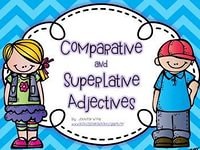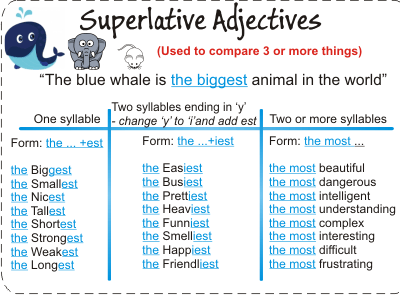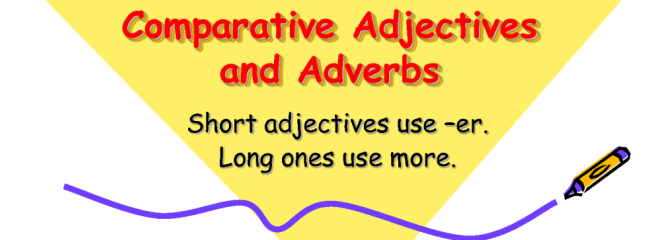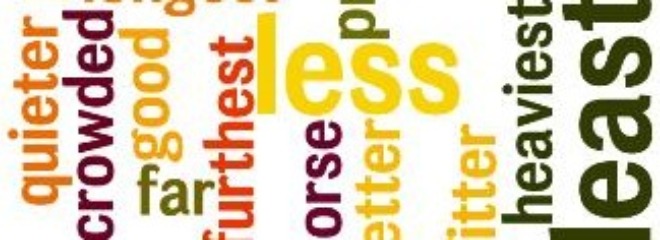Comparative and superlative adjectives
Introduction
One way of describing a person or thing is by saying that they have more of a particular quality than someone or something else. To do this, we use comparative adjectives, which are formed either by adding -er at the end of the adjective, or placing more before it, e.g:
This is a bigger piece of cake.
It is also possible to describe someone or something by saying that they have more of a particular quality than any other of their kind. We do this by using superlative adjectives, which are formed by adding -est at the end of the adjective and placing the before it, or placing the most before the adjective,e.g.:
1. Some rules about forming comparatives and superlatives
(i) one syllable adjectives generally form the comparative by adding -er and the superlative by adding -est, e.g.:
|
Adjective
|
Comparative
|
Superlative
|
| soft | softer | the softest |
| cheap | cheaper | the cheapest |
| sweet | sweeter | the sweetest |
| thin | thinner | the thinnest |
- Note that if a one syllable adjective ends in a single vowel letter followed by a single consonant letter, the consonant letter is doubled, e.g.: thin ? thinner, big ? biggest.
- If an adjective ends in -e, this is removed when adding -er/-est, e.g.: wide ? wider/widest.
- If an adjective ends in a consonant followed by -y, -y is replaced by -i when adding -er/-est, e.g.: dry ? drier/driest.
(ii) more and most are sometimes used with one syllable adjectives as an alternative to the -er/-est form when we particularly want to emphasize the comparison, or if the adjective occurs with another adjective which has more than one syllable, e.g.:
(iii) two syllable adjectives which end in -y usually form the comparative by adding -er and the superlative by adding -est, (note the change of -y to -i in the comparative/superlative) e.g.:
|
Adjective
|
Comparative
|
Superlative
|
| lucky | luckier | the luckiest |
| pretty | prettier | the prettiest |
| tidy | tidier | the tidiest |
(iv) two syllable adjectives ending in -ed, -ing, -ful, or -less always form the comparative with more and the superlative with most, e.g.:
|
Adjective
|
Comparative
|
Superlative
|
| worried | more worried | the most worried |
| boring | more boring | the most boring |
| careful | more careful | the most careful |
| useless | more useless | the most useless |

As a general rule, most other two syllable adjectives also form comparatives and superlatives with more and most, apart from those ending in -y (see (iii) above). However a few two-syllable adjectives can take either -er/-est or more/most. Here are five of the most common examples:
|
Adjective
|
Comparative
|
Superlative
|
| common | commoner/more common | the commonest/most common |
| narrow | narrower/more narrow | the narrowest/most narrow |
| pleasant | pleasanter/more pleasant | the pleasantest/most pleasant |
| useless | more useless | the most useless |
| simple | simpler/more simple | the simplest/most simple |
| quiet | quieter/more quiet | the quietest/most quiet |
(v) Adjectives which have three or more syllables always form the comparative and superlative with more and most, e.g.:
|
Adjective
|
Comparative
|
Superlative
|
| dangerous | more dangerous | the most dangerous |
| difficult | more difficult | the most difficult |
| exciting | more exciting | the most exciting |
| ridiculous | more ridiculous | the most ridiculous |
The only exceptions are some three syllable adjectives which have been formed by adding the prefix -un to another adjective, especially those formed from an adjective ending in -y. These adjectives can form comparatives and superlatives by using more/most or adding -er/-est, e.g.:
|
Adjective
|
Comparative
|
Superlative
|
| unhappy | unhappier | the unhappiest/most unhappy |
| unfriendly | unfriendlier | the unfriendliest/most unfriendly |

(vi) The following adjectives have irregular comparative and superlative forms:
|
Adjective
|
Comparative
|
Superlative
|
| good | better | the best |
| bad | worse | the worst |
| far | farther/further | the farthest/furthest |
The adjectives ill and well, describing bad and good health, have irregular comparative forms. The comparative of ill is worse, and the comparative of well is better, e.g.: She’s feeling much better/worse today.
The usual comparative and superlative forms of the adjective old are older and oldest. However the alternative forms elder and eldest are sometimes used. Elder and eldest are generally restricted to talking about the age of people, especially people within the same family, and are not used to talk about the age of things, e.g.:
It’s the oldest/*eldest castle in Britain.
Elder cannot occur in the predicative position after link verbs such as be, become, get etc., e.g.:
We’re all getting older/*elder.
My brother is older/*elder than me.
(vii) Comparatives and superlatives of compound adjectives are generally formed by using more and most, e.g.:
Going skiing was the most nerve-wracking experience I’ve had.
Some compound adjectives have a first element consisting of an adjective which would normally form a comparative or superlative in one word, either by adding -er/-est, or by an irregular form. Such compound adjectives can therefore form a comparative/superlative by using these changes to the first adjective, rather than by using more/most, e.g.:
|
Adjective
|
Comparative
|
Superlative
|
| good-looking | better-looking | the best-looking |
| long-lasting | longer-lasting | the longest-lasting |
| low-paid | lower-paid | the lowest-paid |
(viii) Some adjectives which already have a comparative or superlative meaning do not usually occur with -er/-est or more/most, unless we want to give special emphasis, often for humorous effect, e.g.:
Mussels are my most favourite food.
Common examples of adjectives like these are: complete, equal, favourite, and perfect.
2. Use of comparatives
Just like other adjectives, comparatives can be placed before nouns in the attributive position, e.g.:
the bigger piece of cake
Comparatives can also occur after be and other link verbs, e.g.:
The street has become quieter since they left.
Comparatives are very commonly followed by than and a pronoun or noun group, in order to describe who the other person or thing involved in the comparison is, e.g.:
John is taller than me.
As well as pronouns and noun groups, than is often followed by other kinds of clause, e.g.:
Comparatives are often qualified by using words and phrases such as much, a lot, far, a bit/little, slightly etc., e.g.:
Could you be a bit quieter?
I’m feeling a lot better.
Do you have one that’s slightly bigger?
Two comparatives can be contrasted by placing the before them, indicating that a change in one quality is linked to a change in another, e.g.:
The more stressed you are, the worse it is for your health.
Two comparatives can also be linked with and to show a continuing increase in a particular quality, e.g.:
The sea was getting rougher and rougher.
Her illness was becoming worse and worse.
3. Use of superlatives
Like comparatives, superlatives can be placed before nouns in the attributive position, or occur after be and other link verbs, e.g.:
As shown in the second two examples, superlatives are often used on their own if it is clear what or who is being compared. If you want to be specific about what you are comparing, you can do this with a noun, or a phrase beginning with in or of, e.g.:
This restaurant is the best in town.
Another way of being specific is by placing a relative clause after the superlative, e.g.:
This offer is the best I’m going to get.
Note that if the superlative occurs before the noun, in the attributive position, the in or of phrase or relative clause comes after the noun, cf:
The best restaurant in town.
The best offer I’m going to get.
Although the usually occurs before a superlative, it is sometimes left out in informal speech or writing, e.g.:
This one seems to be cheapest.
However the cannot be left out when the superlative is followed by an of/in phrase, or a relative clause indicating the group of people or things being compared, e.g.:
This one is the cheapest.
This one is cheapest.
This one is the cheapest of the new designs.
* This one is cheapest of the new designs.
This one is the cheapest I could find.
*This one is cheapest I could find.
Sometimes possessive pronouns are used instead of the before a superlative, e.g.:
my youngest brother
her most valuable piece of jewellery
Ordinal numbers are often used with superlatives to indicate that something has more of a particular quality than most others of its kind, e.g.:
It’s the third largest city in the country.
In informal conversation, superlatives are often used instead of comparatives when comparing two things. For example, when comparing a train journey and car journey to Edinburgh, someone might say: The train is quickest, rather than: The train is quicker. Superlatives are not generally used in this way in formal speech and writing.
4. The opposites of comparative and superlative forms
Comparative and superlative forms with -er/-est and more/most are always used to talk about a quality which is greater in amount relative to others. If we want to talk about a quality which is smaller in amount relative to others, we use the forms less (the opposite of comparative more), and the least (the opposite of superlative the most). Less is used to indicate that something or someone does not have as much of a particular quality as someone or something else, e.g.:
This sofa is less comfortable.
I’ve always been less patient than my sister.
The least is used to indicate that something or someone has less of a quality than any other person or thing of its kind, e.g.:
It’s the least expensive way to travel.
Anchor Point:bottomShe was the least intelligent of the three sisters.







